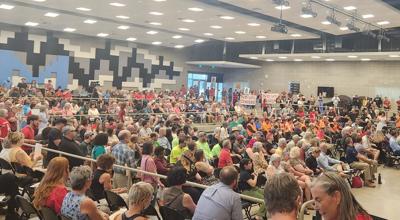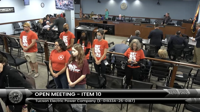
Hundreds of Tucson residents pack a meeting where city officials and developers share details about Project Blue, a proposed data center to be built just outside the city. (Stephanie Casanova / CALÓ News)
While Tucson City Council seems to have closed the door on the proposed Project Blue data center, the questions about resource use in the desert that consumed elected officials, experts and community members this summer may not be over.
A document obtained by Arizona Luminaria from Pima County via a public records request sheds light on what other locations the developer, as of March 2023, had been considering.
The proposed massive data center was one of the largest development projects ever to be considered by the city or county, which, critics warned, would have been an unprecedented drain on Tucson’s water, energy and environment. The Pima County Board of Supervisors voted in June to sell the land to the developer, but the project depended on the city of Tucson to annex the property to supply its water.
On Aug. 5, the day before the city council voted against the project, Council Member Nikki Lee announced in her newsletter that the developers of the Project Blue data center have alternative sites if the city decides not to move forward with the current proposal. Even if the mayor and council vote against the data center, Lee said, its construction is inevitable.
“If the current proposed Phase One site does not move forward with annexation into the City of Tucson, plan B will move forward,” Lee wrote in the newsletter. She said she did not know what “plan B” would be or where the other sites are.
The document, titled “Confidential Response Site Queries - Pima County_Wastewater_rev032423,” lists three other potential development sites near Tucson. Two of the sites are owned by private developers. The third, very near the publicly proposed site, is owned by the State of Arizona.
Pima County spokesperson Mark Evans told Arizona Luminaria the county could only talk about the initial proposed site, and directed further questions to Project Blue representatives.
“Who Project Blue representatives may have contacted about sites other than our site at SELC is best asked of them,” Evans said.
Tucson City Manager Tim Thomure told Arizona Luminaria on Aug. 12 he was unfamiliar with any proposal specific to the locations listed in this document, but acknowledged: “The project developers have several options to develop data centers outside of the City of Tucson.”
Thomure added that the Tucson mayor and council directed him “to establish regulatory guard rails for data centers in Tucson and to develop a ‘Large Water Users Ordinance,’ both of which would need to be in place before any future data center concepts are considered.”
Without Tucson’s water, any developer for a large data center would likely need some other municipality to provide the water. The neighboring town of Marana could be a potential site for a future data center, though the town already has data-center regulations in place.
Where else could Project Blue have gone?
Lynn Cordova, a spokesperson for Arizona State Land Department, told Arizona Luminaria on Aug. 8 that the potential development site owned by the state — the location near the previously named Project Blue site — received a purchase application from Humphrey's Peak Properties LLC in November 2024. Humphrey's Peak is the same company that bought land from Pima County and is named on development documents made public by the city of Tucson.
According to the Arizona Corporation Commission, Humphrey’s Peak incorporated in June 2024 in Delaware. Humphrey’s Peak and Beale Infrastructure list the same Chicago address.
The land appears to have little to no existing water service. According to Pima County GIS data, of the more than 600 acres in the area, 0.1% of the land is within the Tucson Water service area.
In response to questions about alternative sites for Project Blue, Beale sent Arizona Luminaria a published press release.
“Data centers are the physical backbone of the digital world,” the Aug. 8 statement reads. “The people of Southern Arizona rely on this infrastructure daily to check emails, perform critical health and municipal services, enable remote work, stream media and to organize community events. Beale Infrastructure was founded based on the belief that data centers can and should be designed sustainably working in close partnership with communities.”
The statement continues, pointing toward a possible path forward for the Tucson area data center: “We continue to believe there is a win-win solution to bring this record-breaking investment to Tucson.”
“We will continue to engage with the Tucson community on the dialogue around sustainable data center development standards and the role these projects can play advancing Southern Arizona’s economic and technological future.”
In addition to the site for which Humphrey’s Peak has submitted a purchase application, another property is owned by South Wilmot Land Investors LLC — a subsidiary of Diamond Ventures, a development company that was part of the early planning for Project Blue. This site is close to the Wilmot Energy Center, a solar farm. Parcel information from Pima County GIS data indicates the property is partially within the service area of a small water provider owned by Global Water Resources.
Diamond Ventures did not respond to requests for comment.
The third location is on the southwest side. It is owned by SBH Sendero LP — close to Ryan Airfield and a neighborhood. It is within a Metro Water District service area, according to the GIS information from Pima County.
Sendero, a subsidiary of Sunbelt Holdings, didn't immediately respond to requests for comment.
“There are multiple potential paths being explored for Project Blue, outside of the city limits,” Lee told Arizona Luminaria via email on Aug 7.
“While I don’t have information about specific alternative sites, I’ve been made aware that options could include federal land, state land, unincorporated Pima County land, private property, or locations within other jurisdictions in the metro area.”
“While we cannot take action to stop development outside the city limits, we will continue to be a voice for the community and advocate for transparency and the protection of regional resources,” Lee said.
The document, while listing other potential development sites, is focused on wastewater, with the Pima County Wastewater Reclamation Department responding to various technical questions about how much wastewater the county system can handle, what needs to be treated, and if the data center can discharge some of its wastewater without treatment.
The document also lists five potential phases for the data center, instead of the three proposed to the public.
Arizona Luminaria’s Yana Kunichoff contributed reporting for this story.
This article first appeared on AZ Luminaria and is republished here under a Creative Commons Attribution-NoDerivatives 4.0 International License.











(0) comments
Welcome to the discussion.
Log In
Keep it Clean. Please avoid obscene, vulgar, lewd, racist or sexually-oriented language.
PLEASE TURN OFF YOUR CAPS LOCK.
Don't Threaten. Threats of harming another person will not be tolerated.
Be Truthful. Don't knowingly lie about anyone or anything.
Be Nice. No racism, sexism or any sort of -ism that is degrading to another person.
Be Proactive. Use the 'Report' link on each comment to let us know of abusive posts.
Share with Us. We'd love to hear eyewitness accounts, the history behind an article.